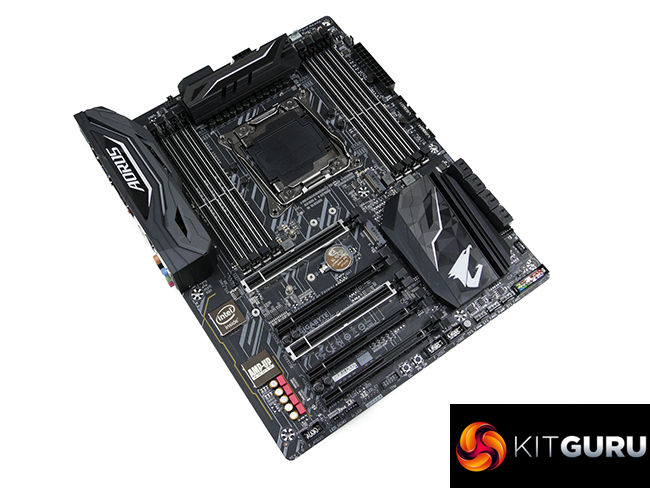The Gigabyte X299 Aorus Gaming 3 is a cost-effective LGA 2066 motherboard that delivers good performance with an aesthetically-friendly design. Gigabyte invests budget into a premium lighting configuration, superb fan control, and a robust set of power delivery components.
Performance from the Gaming 3 is solid. The £270 board stays within touching distance of the significantly more expensive ASUS X299-Deluxe throughout our testing. Overclocked performance is also solid, provided you have the patience to navigate Gigabyte's ageing UEFI implementation and battle against questionable default settings with limited flexibility.
Once overclocked, however, the power delivery solution held up with our 4.6GHz i9-7900X CPU and sensible stress tests. Reported VRM MOSFET temperatures were fairly high, though none of our testing stressed the system for a period long enough to causes rises to concerning levels.
Gigabyte's decision to use a single 8-pin connector is potentially limiting when 12-18 core CPUs are on the horizon. However, the sub-300W connector caused no issues with our default (not de-lidded) Core i9 overclocked using 1.2-1.25V. A more bizarre move is the lack of single PCIe x16 or 2-card x8/x8 (SLI/CF) support when using a 16-lane CPU such as the i7 7740X.
The inherent connectivity of Intel's X299 PCH translates into a strong feature set for the X299 Aorus Gaming 3. Gigabyte supplements the host of USB 3 and SATA ports with an add-on USB 3.1 Gen 2 chipset and dual M.2 slots. Though we didn't see full 1GBps transfers via USB 3.1 Gen 2, the roughly 870MBps speeds were fine. One notable omission was internal USB 3.1 Gen 2 connectivity for future case front panels.
Performance from the M.2 PCIe slots was also on point, despite the lack of cooling. Our Samsung 960 Pro SSD did, however, get hot in the slot beneath a graphics card.
On the topic of cooling, Gigabyte's Smart Fan 5 system is superb. Eight headers spread around the board are all provided with excellent UEFI- and OS-based control and monitoring capabilities. Smart Fan 5 is a market-leading solution that rivals anything the competing vendors can offer. RGB Fusion also deserves similar praise with its strong range of colour and lighting options in addition to intelligent activation modes that work smartly.
The Gigabyte X299 Aorus Gaming 3 is available at Overclockers UK for £269.99 (at the time of writing).
At this price point, Gigabyte has tough competition from MSI's X299 Tomahawk and the ASUS X299-A. Unfortunately for Gigabyte, both of those options outgun the X299 Aorus Gaming 3 when it comes to certain features by offering internal USB 3.1 Gen 2 connectivity, at least one cooled M.2 slot, and far less conflict with storage connectivity. ASUS also ups the competition by providing an OLED display.
Smart Fan 5, RGB Fusion, premium power delivery components, and an eye-catching design are strengths for Gigabyte's X299 Aorus Gaming 3 that allow it to remain an option worthy of consideration.
Discuss on our Facebook page, over HERE.
Pros:
- High-quality International Rectifiers power delivery components.
- Plenty of fan headers and Smart Fan 5 is superb.
- RGB Fusion and onboard LEDs are good.
- Decent MOSFET heatsink with some bulk to it.
- OS software offerings are fairly good.
- Digital LED header plus 5-pin RGBW headers.
- DualBIOS for redundancy, which is useful given the immaturity of the X299 platform.
Cons:
- No internal USB 3.1 Gen 2 header.
- No cooling for either of the M.2 slots.
- Graphics card(s) only run at PCIe x8 or PCIe x8/x4 with a 16-lane CPU – no SLI.
- UEFI layout and styling is ageing and somewhat cumbersome to navigate effectively.
- Some default BIOS options interfere with overclocking and reduce performance (AVX offset, for example).
- Secondary M.2 slot disables four SATA ports (!) in PCIe or SATA mode.
KitGuru says: Built around a smart aesthetic design and high-quality power delivery solution, what Gigabyte's X299 Aorus Gaming 3 lacks in features compared to the competition, it makes up for with Smart Fan 5, RGB Fusion, and other usability benefits.
 KitGuru KitGuru.net – Tech News | Hardware News | Hardware Reviews | IOS | Mobile | Gaming | Graphics Cards
KitGuru KitGuru.net – Tech News | Hardware News | Hardware Reviews | IOS | Mobile | Gaming | Graphics Cards






yawn…..
i was using intel (and only intel) since 2008… but this x299.. no thanks.
i rather buy a threadripper. intel has lost it… too expensive for what it offers.
i am not stupid enough to pay 40% more for 10-20% more real life performance.
and who was the genius that thought using TIM on a high end CPU is a good idea?
my main system is still a x99 but i changed my sandy bridge 2600k system to a ryzen 1700… best CPU deal since 2011. go AMD!!!
AHAHAHAHAAHAHAHHAHA!
AMD SUCKS!